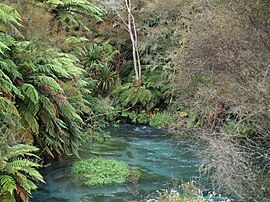TheWaihou Riveris located in the northernNorth Islandof New Zealand. Its former name,Thames River,was bestowed by CaptainJames Cookin November 1769, when he explored 14 mi (23 km) of the river from the mouth. An older Māori name was "Wai Kahou Rounga". A 1947Geographic Boardenquiry ruled that the official name would be Waihou.[1]
| Waihou River Thames River | |
|---|---|
 The Waihou River nearPutāruru | |
 The Waihou River system | |
| Native name | Waihou(Māori) |
| Location | |
| Country | New Zealand |
| Region | Waikato |
| Physical characteristics | |
| Source | Mamaku Ranges |
| • coordinates | 38°4′34″S176°1′52″E/ 38.07611°S 176.03111°E |
| Mouth | Firth of Thames |
• coordinates | 37°10′5″S175°32′30″E/ 37.16806°S 175.54167°E |
• elevation | Sea level |
| Length | 150 kilometres (93 mi) |
| Basin size | 1,982 square kilometres (765 sq mi) |
| Basin features | |
| Tributaries | |
| • right | Ohinemuri River,Komata River,Hikutaia River,Puriri River |
| Bridges | Kopu Bridge |
Geography
editThe river flows north for 150 kilometres (93 mi) from theMamaku Rangespast the towns ofPutāruru,Te Aroha,PaeroaandTurua,before reaching theFirth of Thamesat the south end of theHauraki Gulfnear the town ofThames.In its lower reaches, the river and the nearbyPiako Riverform the widealluvialHauraki Plains.Just before the river reaches the ocean,State Highway 25crosses the river over theKopu Bridge,which was the longest single lane bridge in the country at 463 metres (1,519 ft) and the only remainingswing bridgeon a New Zealand state highway. The bridge was infamous for the queues of vehicles travelling to and from theCoromandel Peninsulauntil a new two lane bridge was opened in December 2011. Tributaries include the Waimakariri Stream, Waiomou Stream, Oraka Stream and theOhinemuri River.[2]
History
editMany areas on the banks of the Waihou River were settled byHauraki Māori,such as Oruarangi pā and Paterangi pā nearMatatoki,and the Te Raupa pā and Waiwhau pā nearPaeroa.[3]The mouth of the river was famous as a location forpātiki(flounder) fishing.[4]
In 1879 Te Au o Tonga,[5]or the Falls of Awotonga, were destroyed by 200 pounds (91 kg) ofdynamiteto free the navigation of the river for shipping. There was a water column of 150 ft (46 m). Other parts of the river had been cleared in the same manner in previous years.[6]Josiah Firth spent £7,442 to 1880, extending navigation for his Kotuku steamer, drawing 3 ft (0.91 m), as far as Stanley Landing,[7]near Gordon.[8]By 1923 a 30 ft (9.1 m) launch could reachOkauia.[9]A 1925 report said there had once been a steady traffic.[10]Regular traffic on the river ended in 1947.[11]
In the 1910s stopbanks and floodgates were constructed along the Waihou River in order to protect farmland from flooding,[12]including a canal constructed at the point where the Waihou River andOhinemuri Rivermeet, west ofPaeroa.[3]Further work occurred in the 1980s after extensive flooding in 1981.[12]
Recreation
editThe river supports large populations ofrainbowandbrown trout.A survey conducted in 2009 showed that the upper section of the river supported over 700 fish per kilometre.[2]
Pollution
editThe water quality at Te Aroha is in the worst category for dissolved reactivephosphorusand also the worst 25% of all sites measured for other pollutants.[13]At Okauia the river is in the worst category forE. coli,[14]though the measurement may have been overestimated.[15]In the upper reaches of the river the main pollutant is phosphorus.[16]Water flows are measured at Te Aroha[17]and Okauia.[18]
References
edit- ^"Waihou River".New Zealand Gazetteer.
- ^ab"Waihou River Trout Fishing".nzfishing.Retrieved21 February2013.
- ^abPrickett, Nigel (1990)."Archaeological Excavations at Raupa: the 1987 Season".Records of the Auckland Institute and Museum.27:73–153.ISSN0067-0464.JSTOR42906403.WikidataQ58677392.
- ^Vennell, Robert (5 October 2022).Secrets of the Sea: The Story of New Zealand's Native Sea Creatures.HarperCollins Publishers Ltd. pp. 84–89.ISBN978-1-77554-179-0.LCCN2021388548.WikidataQ114871191.
- ^"MATAMATA IN THE MAKING. Matamata Record".paperspast.natlib.govt.nz.8 December 1927.Retrieved16 May2023.
- ^"Removal Of A Waterfall By Blasting".The Cornishman.No. 49. 19 June 1879. p. 7.
- ^"OPENING OF UPPER THAMES NAVIGATION. Thames Advertiser".paperspast.natlib.govt.nz.15 March 1880.Retrieved16 May2023.
- ^"Gordon, Waikato".NZ Topo Map.Retrieved16 May2023.
- ^"OKAUIA. Matamata Record".paperspast.natlib.govt.nz.2 August 1923.Retrieved16 May2023.
- ^"MATAMATA. Waikato Times".paperspast.natlib.govt.nz.18 April 1925.Retrieved16 May2023.
- ^"SERVICE ENDS Hauraki Plains Gazette".paperspast.natlib.govt.nz.5 May 1947.Retrieved16 May2023.
- ^abPhillips, Caroline;Green, R. C.(1991)."Further Archaeological Investigations at the Settlement of Waiwhau, Hauraki Plains".Records of the Auckland Institute and Museum.28:147–183.ISSN0067-0464.JSTOR42906415.WikidataQ58677411.
- ^"Waihou River at Te Aroha River Quality".Land, Air, Water Aotearoa (LAWA).Retrieved22 May2023.
- ^"Waihou River at Okauia River Quality".Land, Air, Water Aotearoa (LAWA).Retrieved22 May2023.
- ^NIWA (August 2016)."Modelling E. coli for the Hauraki Plains and Coromandel Peninsula"(PDF).Waikato Regional Council.
- ^"Waihou River at Whites Rd River Quality".Land, Air, Water Aotearoa (LAWA).Retrieved22 May2023.
- ^"Waihou River - Te Aroha - Historical Flows - River level".waikatoregion.govt.nz.Retrieved22 May2023.
- ^"Waihou River - Okauia - River level".waikatoregion.govt.nz.Retrieved22 May2023.
External links
edit- Media related toWaihou Riverat Wikimedia Commons
- 1:50,000 map of source of Waihou River
- South Waikato District Council: Te Waihou Walkway to Blue Spring - with link to youtube video